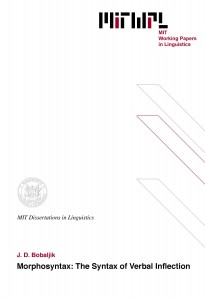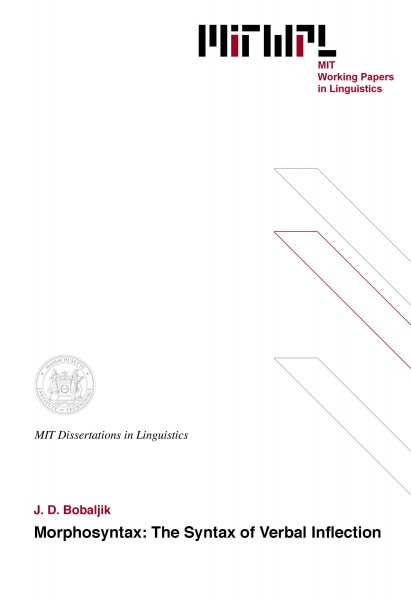Morphosyntax: The Syntax of Verbal Inflection
J. D. Bobaljik, 1995
This thesis investigates the interaction of the morphological process of verbal inflection with the syntactic process of verb movement and the distribution of the principal arguments.
In Part I it is proposed that two apparently syntactic phenomena in the Germanic languages are accounted for by allowing the morphological component to filter syntactic derivations. First (Chapter I), it is proposed that the parametric variation in the licensing of the specifier of TP (an intermediate functional projection) can be derived from the verbal inflectional paradigms; certain morphological patterns require fusion, a requirement which in turn places restrictions on possible syntactic derivations. In Chapter II it is proposed that verbal inflection may take place via morphological merger, which requires adjacency. Syntactic operations which would disrupt the adjacency relation in the morphology are therefore blocked.
In Part II the assumptions, common in the literature, which underlie the syntactic analyses in Part I are reconsidered. In particular it is argued in Chapter III that the base and derived positions of the principal arguments are stacked; that is, objects do not cross over subjects in moving to their derived position. In Chapter IV the view that floating quantifiers mark the positions of traces of their antecedents is challenged.
Part III attempts to salvage and extend the accounts of Part I in light of the revised assumptions proposed in Part II. In Chapter V I introduce the Free Agr Parameter, which states that languages vary with regard to the presence or absence of Agr-Phrases. The specifiers of Agr-Phrases are the derived positions for arguments as evidenced by object shift and other phenomena. It is also proposed that the presence or absence of an Agr head dominating Infl determines whether or not the verb raises out of the VP in non-verb-second environments, correctly predicting a further point of parametric variation in the Germanic languages. Chapter VI investigates the possibility of pursuing these analyses while maintaining that the syntactic derivation cannot be filtered by the morphophonological component(s). It is argued that this is possible, if the grammar admits of a process determining which copy of a moved element is pronounced. The morphological procedure determining which copy is pronounced is constrained by other morphological considerations, especially the adjacency condition on morphological merger investigated in Chapter II.
Thesis Supervisors: Professor Noam Chomsky, Institute Professor
and Professor David Pesetsky, Professor of Linguistics
<br/>
Table of Contents
Introduction: The Syntax of Verbal Inflection............................................................ 15
Part I—Morphosyntax.......................................................................................... 15
Part II—Syntax...................................................................................................... 17
Part III—Morphosyntax revisited........................................................................ 20
Part I—Morphosyntax
Chapter 1: Fitting Fused Functional Heads................................................................ 24
1.1. Syntax—The Spec,TP parameter......................................................................... 26
1.2. Morphology—Fusion and complex heads........................................................... 32
1.3. The Analysis........................................................................................................ 36
1.3.1. Icelandic versus English............................................................................. 36
1.3.2. The full paradigm....................................................................................... 39
1.3.2.1. German and Dutch............................................................................... 41
1.3.2.2. Mainland Scandinavian........................................................................ 42
1.3.2.3. Yiddish and Afrikaans......................................................................... 43
1.3.2.4. Faroese................................................................................................. 45
1.3.3. Summary.................................................................................................... 48
1.4. Learnability and morpho-syntax tensions............................................................ 49
1.5. Concluding remarks.............................................................................................. 52
Chapter 2: What Does Adjacency Do?.......................................................................... 53
2.1. Affixes and adjacency........................................................................................... 55
2.2. English inflection and do-support........................................................................ 59
2.2.1. What adjacency does................................................................................. 59
2.2.2. Beyond the obvious—Other instances of do-support.............................. 68
2.3. Object Shift.......................................................................................................... 74
2.3.1. OS-1—The SVO languages........................................................................ 75
2.3.2. Object Shift II—The SOV languages......................................................... 85
2.4. Extensions............................................................................................................ 87
2.4.1. Modern Irish complementizers................................................................. 88
2.4.1.1. The problem........................................................................................ 88
2.4.1.2. IP-adjuncts........................................................................................... 89
2.4.1.3. Against syntactic lowering—NPI licensing......................................... 92
2.4.2. Bambara transitive perfectives.................................................................. 96
2.5. Conclusion.......................................................................................................... 104
Part II—Syntax
Chapter 3: Leapfrogging and Stacking...................................................................... 110
3.1. In this corner … The arguments for leapfrogging............................................... 117
3.1.1. Equidistance, Shortest Move, and Holmberg’s generalization................ 117
3.1.1.1. Object Shift in SOV Germanic is Object Shift................................... 123
3.1.1.2. Parasitic gaps and pseudo-gaps......................................................... 134
3.1.1.3. Holmberg’s generalization also fails in Irish...................................... 143
3.1.2. Floating quantifiers and Object Shift....................................................... 145
3.1.2.1. Painting the houses red...................................................................... 146
3.1.2.2. FQs and double-object constructions................................................ 149
The architecture of double-object constructions................................. 150
3.2. And in this corner … Arguments for stacking................................................... 159
3.2.1. Jonas & Bobaljik 1993............................................................................. 162
3.2.2. Evidence from mapping........................................................................... 166
3.2.3. Object Shift in Modern Irish................................................................... 171
3.2.4. The indirect object always comes first.................................................... 174
3.2.4.1. The higher IO position is lower than the lowest S position.............. 177
3.2.4.2. The lower IO position is higher than the highest DO position......... 179
3.2.4.3. Swedish.............................................................................................. 184
3.3. Conclusion.......................................................................................................... 187
Chapter 4: Floating Quantifiers Are Adverbs........................................................... 191
4.1. On all and similar things..................................................................................... 194
4.2. The distribution of floating quantifiers.............................................................. 203
4.2.1. DP trace, not left edge of predicate = *FQ.............................................. 204
4.2.2. Left edge of predicate, no DP trace = ? FQ............................................ 212
4.2.3. PRO and event modification.................................................................... 217
4.2.4. Another problem for [all PRO]: Case mismatch..................................... 221
4.2.5. All can’t always be a part of the trace..................................................... 223
4.3. The adverbial nature of floating quantifiers........................................................ 226
4.3.1. Floating quantifier–adverb interactions................................................... 227
4.3.2. Floating and prenominal chacun ‘each’................................................... 235
4.3.3. Adverbial interpretive rules, all together …............................................ 238
4.4. Conclusion: Some final remarks on c-command and agreement......................... 242
4.4.1. Antecedent must be an A-position.......................................................... 243
4.4.2. Antecedent must precede or c-command FQ.......................................... 244
4.4.3. Predicted ambiguity of antecedents......................................................... 248
Part III—Morphosyntax Revisited
Chapter 5: The Free Agr Parameter: NP Positions, Morphology and Verb Movement....................................................................................................................... 252
5.1. The Free Agr Parameter..................................................................................... 257
5.2. Verb raising. An account.................................................................................... 267
5.2.1. The assumptions..................................................................................... 267
5.2.2. The simple case: I + V............................................................................. 272
5.2.3. Verb Second—CV2................................................................................... 276
5.2.4. V2—The analysis.................................................................................... 283
5.2.5. Complex IP = AgrP + IP......................................................................... 286
5.2.6. Conclusion............................................................................................... 293
5.3. Extensions. Triggers for movements.................................................................. 297
5.3.1. “Affix” is not a syntactic feature............................................................. 299
5.3.2. Last resort................................................................................................ 308
5.4. Attraction is myopic: The mechanism of verb raising....................................... 324
5.5. Postscript—Auxiliaries...................................................................................... 330
5.5.1. Swedish.................................................................................................... 331
5.5.2. Optional infinitives.................................................................................. 333
5.5.3. German.................................................................................................... 334
Chapter 6: Object Shift as a morphological phenomenon...................................... 337
6.1. Holmberg’s generalization again......................................................................... 339
6.1.1. Object Shift and adjacency...................................................................... 339
6.1.2. Object Shift revisited............................................................................... 343
6.2. Copy pronunciation: Single Output Syntax....................................................... 348
6.3. Extending the system—Some speculations........................................................ 354
6.3.1. A'-movement at LF: Apparent Subjacency violations............................ 355
6.3.2. On Agr-Phrases....................................................................................... 361
6.3.3. Null affixes and pronunciation................................................................. 363

